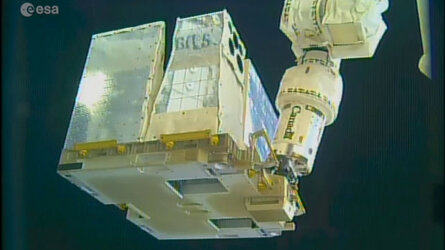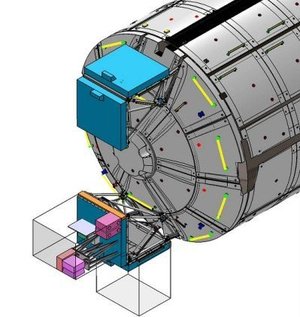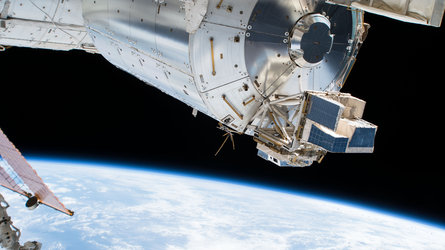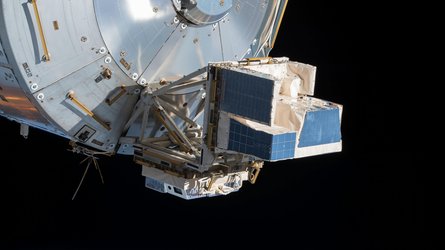Accept all cookies Accept only essential cookies See our Cookie Notice

About ESA
The European Space Agency (ESA) is Europe’s gateway to space. Its mission is to shape the development of Europe’s space capability and ensure that investment in space continues to deliver benefits to the citizens of Europe and the world.
Highlights
ESA - United space in Europe
This is ESA ESA facts Member States & Cooperating States Funding Director General Top management For Member State Delegations European vision European Space Policy ESA & EU Space Councils Responsibility & Sustainability Annual Report Calendar of meetings Corporate newsEstablishments & sites
ESA Headquarters ESA ESTEC ESA ESOC ESA ESRIN ESA EAC ESA ESAC Europe's Spaceport ESA ESEC ESA ECSAT Brussels Office Washington OfficeWorking with ESA
Business with ESA ESA Commercialisation Gateway Law at ESA Careers Cyber resilience at ESA IT at ESA Newsroom Partnerships Merchandising Licence Education Open Space Innovation Platform Integrity and Reporting Administrative Tribunal Health and SafetyMore about ESA
History ESA Historical Archives Exhibitions Publications Art & Culture ESA Merchandise Kids Diversity ESA Brand Centre ESA ChampionsLatest
Space in Member States
Find out more about space activities in our 23 Member States, and understand how ESA works together with their national agencies, institutions and organisations.
Science & Exploration
Exploring our Solar System and unlocking the secrets of the Universe
Go to topicAstronauts
Missions
Juice Euclid Webb Solar Orbiter BepiColombo Gaia ExoMars Cheops Exoplanet missions More missionsActivities
International Space Station Orion service module Gateway Concordia Caves & Pangaea BenefitsLatest
Space Safety
Protecting life and infrastructure on Earth and in orbit
Go to topicAsteroids
Asteroids and Planetary Defence Asteroid danger explained Flyeye telescope: asteroid detection Hera mission: asteroid deflection Near-Earth Object Coordination CentreSpace junk
About space debris Space debris by the numbers Space Environment Report In space refuelling, refurbishing and removingSafety from space
Clean Space ecodesign Zero Debris Technologies Space for Earth Supporting Sustainable DevelopmentLatest
Applications
Using space to benefit citizens and meet future challenges on Earth
Go to topicObserving the Earth
Observing the Earth Future EO Copernicus Meteorology Space for our climate Satellite missionsCommercialisation
ESA Commercialisation Gateway Open Space Innovation Platform Business Incubation ESA Space SolutionsLatest
Enabling & Support
Making space accessible and developing the technologies for the future
Go to topicBuilding missions
Space Engineering and Technology Test centre Laboratories Concurrent Design Facility Preparing for the future Shaping the Future Discovery and Preparation Advanced Concepts TeamSpace transportation
Space Transportation Ariane Vega Space Rider Future space transportation Boost! Europe's Spaceport Launches from Europe's Spaceport from 2012Latest

New location, same ASIM
Thank you for liking
You have already liked this page, you can only like it once!
The first-of-its-kind complement of instruments dubbed the ‘space storm hunter’ hangs out in its new location outside the International Space Station in this image taken by on of the Station’s external cameras.
The Atmosphere–Space Interactions Monitor, or ASIM for short, measures electric events in Earth’s upper atmosphere with cameras, photometers and X- and gamma-ray detectors.
Last week ASIM was switched off and moved by robotic arm to another spot outside the Columbus module to make room for an American payload. Now in its new location, the instrument is being activated and so far things are going well.
From its new vantage point, just next to its current one, ASIM is pointing in a different direction, slightly more towards the horizon instead of straight down. This will help researchers work out how much the atmosphere at different altitudes influences the processes of electrical discharges. It’s like viewing a firework display: one can enjoy the shapes more from the side than if one is just below the display!
Though designed to look for electrical discharges born in stormy weather conditions in Earth’s upper atmosphere, ASIM recently detected a unique gamma-ray burst from outer space.
The spurt turned out to be from an explosive giant flare from a magnetar located 10 million light-years away in a distant galaxy. Magnetars are a special type of neutron star – the collapsed core of what was once a supergiant star. This fortuitous observation was published in the December issue of Nature magazine.
ASIM was built by Danish company Terma, the Danish Technical University, the University of Bergen in Norway and the University of Valencia in Spain for the European Space Agency. ASIM's in-orbit operations are overseen from the Belgian User Support and Operations Centre (B.USOC) in Brussels Belgium.
-
CREDIT
ESA/NASA -
LICENCE
ESA Standard Licence

Robotically moving ASIM the storm hunter on the Inte…

ASIM equipment on CEPA

ASIM on Columbus

ASIM in action















 Germany
Germany
 Austria
Austria
 Belgium
Belgium
 Denmark
Denmark
 Spain
Spain
 Estonia
Estonia
 Finland
Finland
 France
France
 Greece
Greece
 Hungary
Hungary
 Ireland
Ireland
 Italy
Italy
 Luxembourg
Luxembourg
 Norway
Norway
 The Netherlands
The Netherlands
 Poland
Poland
 Portugal
Portugal
 Czechia
Czechia
 Romania
Romania
 United Kingdom
United Kingdom
 Slovenia
Slovenia
 Sweden
Sweden
 Switzerland
Switzerland
























